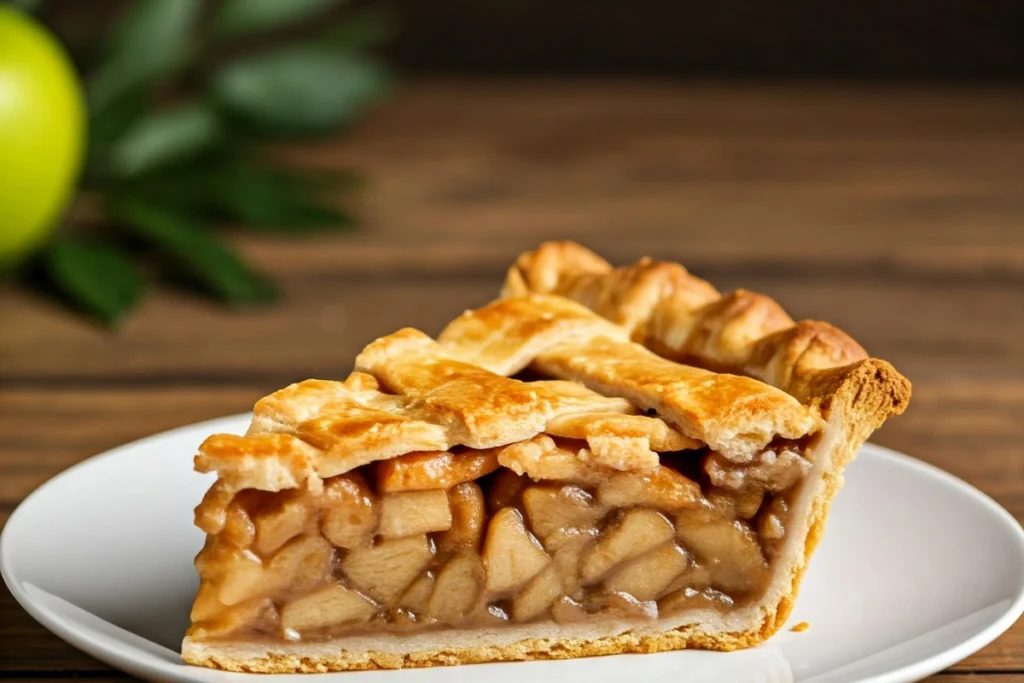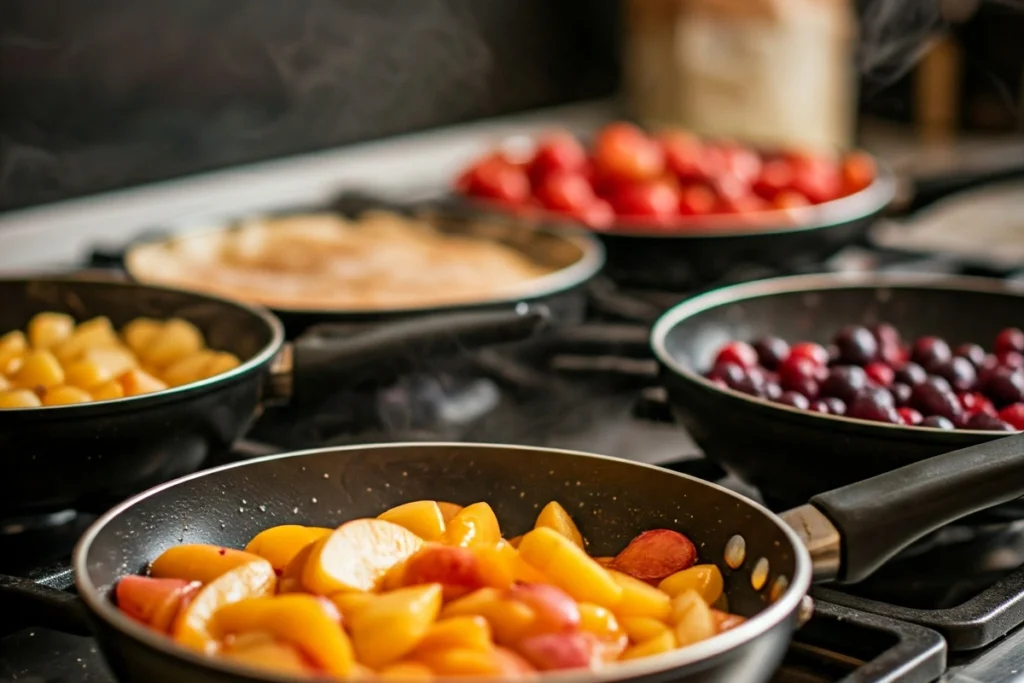Fruit pies are a beloved dessert, but when it comes to preparing the filling, bakers often face a dilemma: should you cook fruit pie filling before baking? This question has stirred up kitchens and sparked debates among pie enthusiasts and professional bakers alike. Some argue that cooking the filling first ensures a perfectly balanced pie, while others insist that raw fruit preserves freshness and vibrancy.
In this article, we’ll delve into the science and art of pie-making, breaking down the pros and cons of cooking your filling. From techniques to expert opinions, we’ll guide you toward making the best choice for your next pie adventure. Whether you’re a seasoned baker or a curious beginner, this guide is here to make your pies sweeter, juicier, and more satisfying.
Introduction to Fruit Pie Filling and Baking
What Is Fruit Pie Filling?
Fruit pie filling is the heart and soul of every fruit pie. It’s a luscious combination of fruits, sweeteners, thickeners, and spices that transforms simple ingredients into a delectable masterpiece. Depending on the fruit used—like apples, cherries, or berries—the filling can vary in sweetness, texture, and juiciness.
What makes fruit pie filling unique is its versatility. Some fillings are cooked to achieve a smooth, jam-like consistency, while others rely on raw fruit to deliver fresh, vibrant flavors. How you handle the filling plays a crucial role in the final pie’s taste and structure.
Why the Debate: To Cook or Not to Cook?
So, should you cook fruit pie filling before baking? The debate largely stems from preferences in taste and texture. Cooking the filling allows the flavors to meld and ensures a more consistent result. On the other hand, baking raw fruit can yield a fresher, chunkier filling with more bite.
Factors like the type of fruit, desired consistency, and baking method all influence this decision. For instance, high-water-content fruits like peaches might need pre-cooking to prevent a soggy crust, while firmer fruits like apples can often bake to perfection without pre-cooking.
In the following sections, we’ll explore the science behind these choices, the techniques involved, and tips to make your fruit pies extraordinary. Whether you choose to cook or not, understanding the basics will empower you to bake with confidence.
The Science of Cooking Pie Filling
The Role of Temperature in Thickening Fillings
Cooking fruit pie filling before baking allows you to harness the magic of temperature to achieve the right consistency. Heat activates thickeners like cornstarch or tapioca, ensuring they dissolve evenly and bind the filling into a cohesive mixture. This process eliminates the guesswork of relying solely on oven heat to do the job, which can sometimes leave parts of your pie runny.
By controlling the temperature on the stovetop, you can test the filling’s thickness before it’s even poured into the crust. For high-moisture fruits, such as peaches or berries, pre-cooking prevents sogginess by reducing excess liquid in advance. The result? A filling that’s not only flavorful but also easier to slice cleanly when served.
How Cooking Impacts Flavor and Texture
Pre-cooking enhances the flavor profile of your pie. Heat helps fruits release their natural juices, allowing the sugar and spices to meld beautifully. Imagine a warm apple pie filling enriched with cinnamon, nutmeg, and a hint of vanilla—delicious, right?
Texture also benefits from pre-cooking. Firmer fruits like apples soften slightly during this process, making them tender without turning to mush. On the other hand, berries retain their shape better when pre-cooked briefly, giving you the best of both worlds: a filling that’s juicy but not watery.
Cooking the filling is especially helpful when using frozen fruit, which can contain added moisture that’s tricky to manage otherwise. If you’ve ever asked, should you cook fruit pie filling before baking, now you know it’s the key to controlling both texture and flavor.
Benefits of Cooking Pie Filling Before Baking
Achieving a Consistent Texture
Pre-cooked fillings deliver consistency, ensuring each bite of your pie has the perfect balance of flavors and textures. By heating the ingredients beforehand, you reduce the risk of uncooked patches or overly watery spots. This method is especially effective for pies with intricate designs, like lattice tops, where undercooked fillings can ruin the overall presentation.
Cooked fillings also allow bakers to adjust their consistency on the spot. Too runny? Add more thickener. Too thick? Stir in a splash of water or fruit juice. Such control is a luxury you don’t get with raw fillings.
Preventing Undercooked Fillings in Large Pies
Deep-dish pies and large-scale bakes often present a challenge: ensuring the filling is thoroughly cooked while avoiding a burnt crust. By cooking the filling in advance, you give the fruit a head start, reducing the time it spends in the oven.
This method also works wonders for bakers dealing with uneven ovens or short baking windows. Pre-cooked fillings guarantee that even dense fruits like pears or cherries bake evenly without compromising the crust’s crispness.
Drawbacks of Cooking Pie Filling Before Baking
Potential Over-Thickening Issues
One of the main concerns when pre-cooking pie filling is the risk of over-thickening. While heating, starches like cornstarch or tapioca may bind too much liquid, resulting in a dense, gluey texture. This problem is particularly noticeable when using high-pectin fruits like apples or peaches, which naturally thicken as they cook.

To avoid this, it’s crucial to monitor the consistency closely during pre-cooking. A good rule of thumb is to stop cooking the filling when it’s slightly runnier than your desired end result. Remember, the filling will thicken further while baking in the oven.
Flavor Concentration: When It’s Too Much
Cooking fruit pie filling before baking intensifies flavors, but there’s a fine line between rich and overpowering. Overcooking can concentrate sugars and spices to the point where they overshadow the natural taste of the fruit. This is especially true for delicate berries or tropical fruits, whose subtle flavors might get lost in the process.
For those seeking a fresh and vibrant taste, raw filling might be a better option. Additionally, using raw fruit can create a pleasing contrast between the cooked crust and the bright, juicy filling.
If you’re curious about balancing flavor and texture in other dishes, check out Simita Recipes’ Mango Pie Recipe for inspiration.
Different Fruits, Different Rules
Apples and Pears: Cooking Recommendations
When it comes to firmer fruits like apples and pears, pre-cooking is often a smart choice. These fruits release their juices slowly and require time to soften, making them prone to uneven cooking when used raw. Pre-cooking ensures they’re tender and prevents a watery mess in the pie.
For apple pies, partially cooking the slices with sugar and spices on the stovetop lets you control their sweetness and texture. Pear pies benefit from a similar approach, as pears tend to over-soften if baked for too long.
Berries: A Raw Approach for Freshness
Berries, such as blueberries, raspberries, and blackberries, often shine brighter when used raw. Their delicate structure breaks down quickly under heat, making them ideal for direct baking. However, adding a small amount of thickener to the raw mixture helps manage their high water content.
For mixed berry pies, consider pre-cooking only a portion of the berries to achieve a balanced texture while preserving the vibrant freshness of the raw fruit.
Stone Fruits: Balancing Pre-Cooking and Freshness
Stone fruits like peaches, plums, and cherries offer more flexibility. While they can be pre-cooked for a smoother filling, many bakers prefer to use them raw for their vibrant, juicy appeal. If you’re using frozen stone fruits, pre-cooking becomes essential to reduce excess water and maintain a firm crust.
Techniques for Cooking Pie Filling
Stovetop Cooking Method
The stovetop is one of the most effective ways to pre-cook pie fillings. By gently heating the fruit with sugar, spices, and thickeners like cornstarch, you gain precise control over the texture and consistency. This method works exceptionally well for firmer fruits like apples or pears, where even heat helps release their juices without making them mushy.

To get started, toss your fruit with sugar and any spices. Let the mixture sit for a few minutes to draw out the juices. Then, cook it over medium heat, stirring frequently, until the liquid thickens and the fruit softens to your liking. The key here is to avoid overcooking—remember, the filling will cook further in the oven.
Microwave Options for Smaller Batches
For smaller pies or quick fixes, the microwave can be a lifesaver. This method is ideal for softer fruits like berries, which don’t require extensive cooking. Simply combine your fruit, sugar, and thickener in a microwave-safe bowl. Heat in short intervals, stirring between each session, until the mixture thickens.
While the microwave doesn’t offer the same level of control as the stovetop, it’s a quick and convenient option for bakers in a hurry.
Using Thickeners Like Cornstarch or Tapioca
Thickeners are the unsung heroes of pre-cooked pie fillings. They help bind the juices into a cohesive mixture, preventing your pie from turning into a soggy mess. Cornstarch is a go-to for many bakers, as it’s easy to use and creates a glossy finish. Tapioca, on the other hand, works well for fillings with high water content, like berry pies.
When using thickeners, it’s important to cook the filling until you see it reach a bubbling boil. This ensures the thickener is fully activated, giving your pie the perfect consistency.
Cases Where Cooking Filling Is Essential
Thickened Custard-Based Fillings
If you’re making a custard-based pie like lemon meringue or coconut cream, cooking the filling is non-negotiable. Custards rely on the precise thickening of eggs, sugar, and cornstarch to achieve their smooth texture. Without pre-cooking, these ingredients won’t set properly, resulting in a runny pie.
For fruit pies with added custard, such as strawberry cream pies, pre-cooking the fruit ensures the filling layers stay distinct and visually appealing.
Deep-Dish Pies: Managing Long Bake Times
Deep-dish pies are another scenario where pre-cooking is a must. These pies often have thicker layers of fruit, which can take longer to heat through in the oven. Pre-cooking the filling helps jump-start the process, ensuring the fruit cooks evenly without leaving raw spots in the center.
This technique also protects the crust from over-baking, as the pie requires less overall time in the oven. So, if you’ve ever wondered, should you cook fruit pie filling before baking?, deep-dish pies are a clear yes.
Ready to explore expert opinions and more tips in the next sections? Let me know when to continue!
Expert Opinions on Pie Filling Preparation
Bakers Who Recommend Cooking
Many professional bakers advocate for cooking fruit pie filling before baking, emphasizing the control it provides. According to these experts, pre-cooking ensures a uniform texture and allows the baker to tweak the flavor balance before the pie goes into the oven. This is particularly valuable when working with fruits that have varying levels of sweetness or moisture, like apples or mixed berries.
Some chefs also highlight the importance of cooking fillings for recipes that require a firm, sliceable texture. Imagine cutting into a cherry pie only to watch the filling spill out—it’s moments like these that cooking can prevent. For deep-dish or lattice pies, this method is often the gold standard.
Proponents of the Raw Filling Method
On the other hand, there are bakers who champion raw fruit fillings, arguing that this approach preserves the natural flavors and textures of the fruit. By skipping the pre-cooking step, the fruit retains its structure, offering a fresh, vibrant bite.
Raw fillings are particularly popular for smaller pies or tarts, where the thinner layers of fruit cook quickly in the oven. These bakers suggest that with the right thickener and baking time, raw fillings can yield excellent results.
Ultimately, the question should you cook fruit pie filling before baking depends on your priorities. Whether it’s consistency, flavor, or convenience, each method has its merits.
FAQs About Cooking Pie Filling
Do All Fruit Pies Require Pre-Cooked Fillings?
Not at all! While pre-cooking works wonders for many types of fruit, it’s not always necessary. Berries, for instance, often do well in raw fillings because they break down easily under oven heat. Similarly, if you’re aiming for a rustic, homey feel, raw fillings can add charm and simplicity.
Can You Overcook Pie Filling Before Baking?
Yes, and it’s a common pitfall. Overcooking the filling can make the fruit mushy and cause thickeners to become overly stiff. To avoid this, stop cooking when the mixture is slightly less thick than your desired consistency—it will thicken further during baking.
Is It Better to Cook Filling for Frozen Pies?
Absolutely. Frozen fruit tends to release more water as it thaws, which can lead to a watery pie. Pre-cooking the filling allows you to reduce this excess moisture, ensuring the pie bakes evenly.
For bakers tackling frozen fruit pies, pre-cooking is the best way to manage liquid and achieve that perfect, jammy consistency.
Looking for more pie-making inspiration? Check out our guide on creating delicious Peach Mango Pie for a tropical twist on classic desserts!

